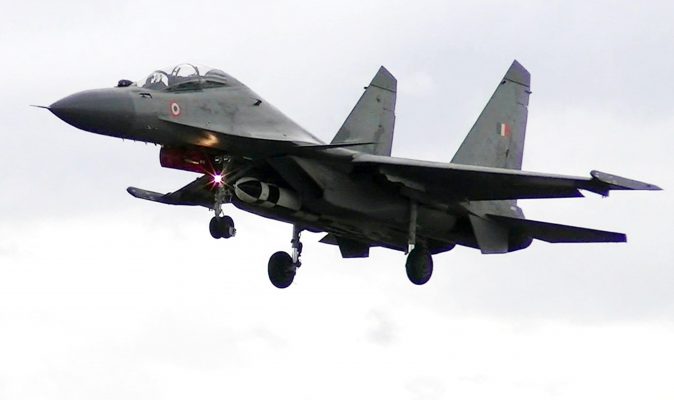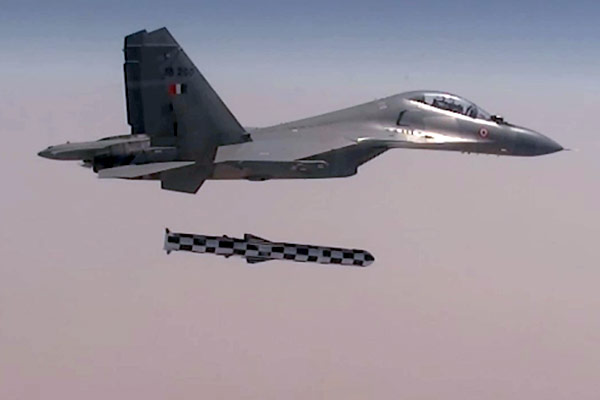
Basing the versatile and long-legged Sukhois armed with the air launched BrahMos in Thanjavur allows the Indian Air Force to strike at Chinese naval assets far out at sea.
On January 20, the Indian Air Force (IAF) formally inducted its Sukhoi-30MKI air dominance fighter into the recently resurrected No. 222 Squadron, also known as The Tigersharks, at Thanjavur Air Force Station in Tamil Nadu. This is the IAF’s second frontline fighter squadron to be based in the south after the No.45 Flying Daggers squadron operating the Tejas light combat aircraft from Sulur airbase near Coimbatore. The Tigersharks squadron was first raised on September 15, 1969 with another Sukhoi fighter, the Su-7, and later with the MiG-27 ground-attack aircraft.
According to Chief of Defence Staff General Bipin Rawat, the Su-30MKI which is mated with the 300-km range BrahMos supersonic air launched cruise missile will be game changer. “It will enhance the might of our own maritime domain,” he said at the inaugural ceremony in Thanjavur.
Thanjavur Air Force Station was activated in 2013 with the primary aim of strengthening the air defence capabilities under Southern Air Command headquartered in Thiruvananthapuram, Kerala. The air base was mandated to protect various strategic and economic assets in the southern peninsula and sea lines of communication in the Indian Ocean region.
Strategic location
The new air base can be equated to an aircraft carrier sitting on land. As well as providing air cover to Indian naval operations in the region, the squadron in Thanjavur will keep in check China’s fast-expanding strategic footprint in waters near India. Beijing set up its first overseas military base in Djibouti on the Horn of Africa in August 2017, and also uses Karachi as a regular naval facility.
The Sukhois armed with the BrahMos now provide previously unavailable air defence capability in the peninsular region. With the BrahMos armed Sukhois at Thanjavur, the IAF has more air power to strike from long standoff distances on targets at sea or on land with pinpoint accuracy by day or night and in all weather conditions.
Why the Sukhoi?
The Su-30 MKI has a range of 3,000 km on internal fuel which ensures a three-hour combat mission. It also has in-flight refuelling capability which increases the flight duration to 10 hours with a range of at least 5,200 km. The most lethal features of any fighter aircraft are its sensors and weapons. Its powerful radar functions in air-to-air and air-to-land/sea mode simultaneously while being tied to a high-precision laser-inertial or GPS navigation system. It is equipped with modern digital weapons control and electronic counter measure systems. The fighter can carry a load of up to 8,000 kg, including a wide range of weapons.
The Su-30MKI, while based on an air superiority airframe, is equally capable in the ship hunting role. The Sukhoi’s most prominent strike capability comes from its access to the BrahMos cruise missile – an India-Russia joint platform capable of striking targets at speeds of up to Mach 3 – and disabling most warships with a single well placed strike. In tests, the missile has cut warships in half. The air launched variant of the BrahMos allows the Sukhoi to serve as a ship hunter. Future variants include a hypersonic missile and an extended range (450-800 km) weapon that will considerably boost the lethality of the Sukhoi-BrahMos combination. As well has having to deal with the constant shadowing by US and Japanese fleets, Chinese warships now have to reckon with this powerful new threat from India. They will be forced to operate well away from Indian shores. Not a happy scenario if you are PLA Navy war planner.

Long range and two fronts
With the induction of large numbers of class leading Sukhoi-30MKI fighters, the IAF has not only made a huge technological transition from a MiG-21 dominated fleet, its war fighting doctrine has also changed, focusing on long-range and strategic missions.
It was with the MiG-29 Fulcrum that the IAF for the very first time acquired a superior aircraft compared with those operated by the PAF. However, the qualitative edge was marginal. On the other hand the Sukhoi-30 MKI is an “air dominance fighter” that is allowing the IAF to perform a multiplicity of missions required to keep in step with India’s rising global stature. The Sukhoi’s versatility – owing to its extended range, speed, firepower and super-manoeuvrability – has given the IAF considerable leeway in deploying the aircraft in offensive missions.
In April 2013 the IAF held its largest-ever combat exercise involving as many as 400 combat aircraft plus 200 transport planes and helicopters. The exercise was aimed at testing the IAF’s capability for a two-front war against China and Pakistan, by deploying “swing forces” from the western theatre right across to the east. As part of the war games, Sukhoi-30MKIs flew 1,800 km bombing missions from Assam to the western front, with mid-air refuelling. This is possible because the Sukhoi has a range of 4.5 hours on internal fuel, and IAF pilots are known to lead missions over 10 hours.
A much larger exercise, Operation Gaganshakti, in 2018 affirmed the IAF’s confidence in its ability to fight a two-front war if required.
Complex missions require powerful navigation systems. India has chosen to buy barebones Sukhois from Russia and then cram them with Israeli and French equipment. Plus, the already excellent Bars radar, which can track an aircraft at 125 km and a battle tank 40 km away, is being replaced with the Russian Zhuk active electronically scanned array (AESA) radars. In air-to-surface mode, the Zhuk can detect a naval destroyer up to 300 km away, and up to two surface targets can be tracked at once. This long-range detection capability – in tandem with the tremendous hitting power of the BrahMos – dramatically increases the vulnerability of Chinese warships if they venture too close to Indian waters.
Numbers game
It is a fact that quantity has a quality all its own. Including aircraft under order, India’s Sukhoi-30 MKI fleet is currently pegged at around 272, and is set to cross 300. It is an impressive number for such a high-end and expensive weapons platform. This shows a keen sense of judgement by the IAF, which realises that 100 per cent fleet utilisation is impossible and having a large number of air superiority aircraft around is the key to getting the job done.
With such numbers at its disposal, the IAF is now able to build a network of bases around the country. Earlier, because of the low range of its fighter aircraft and coupled with the fact that the IAF had to quickly deploy them in war, most Indian air bases – such as Adampur, Jammu, Amritsar and Jodhpur – were close to the Pakistan border.
But now the IAF can afford to station Sukhois at places such as Thanjavur in the deep south, Chabua in the northeast and Pune in western India. Because of its long legs and speed the Sukhois can join battle at a few hours notice.
Limits of the Sukhoi
The IAF describes the Sukhoi as its air dominance fighter, which is a clear indication that the aircraft’s primary role is establishing air superiority so that other fighter jets can operate with near impunity during war. Unlike the Boeing F/A-18 or the Russian Su-33, the Su-30MKI was not designed for operations at sea and will therefore deliver much lower performance levels over water. The aircraft is therefore a stopgap arrangement rather than a permanent fix for a very pressing problem – increasing number of Chinese warships in waters close to India. The Chinese may eventually develop ship-based long-range surface-to-air missiles that can neutralise the Sukhoi threat from Thanjavur.
The IAF is forced to use the Sukhois in a maritime role because in previous decades the service preferred to focus on the theatre level while steadfastly refusing to grow a strategic wing. Fighters were given preference over a bomber fleet. During the 1980s when the Indira Gandhi government gave the green signal for the acquisition of the powerful Backfire bomber from the Soviet Union, it was the IAF that backed off.
In view of the increasing threat from Chinese naval fleets which now have a near permanent presence in the Indian Ocean, what India needs is a maritime strike bomber. A long-range bomber operating from well-defended airbases deep inland – and armed with the 300-800 km range BrahMos – can comfortably strike naval assets in the southern Indian Ocean. These aircraft can also be used to target PLA Navy vessels operating in the South China Sea. Such an aircraft would be a huge force multiplier for India.
The Sukhois can then return to doing what they do best – scaring the pants off enemy air force pilots.
The author is a New Zealand based defence analyst. His work has been quoted extensively by leading think tanks, universities and publications worldwide








